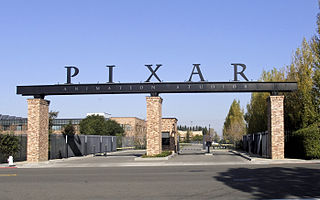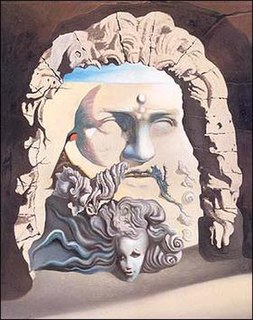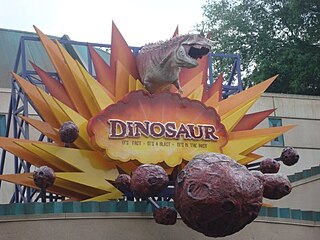
Pixar Animation Studios, commonly known as Pixar, is an American computer animation studio known for its critically and commercially successful computer animated feature films. It is based in Emeryville, California, United States, and is a subsidiary of Walt Disney Studios, which is another studio owned by The Walt Disney Company.
Modern animation in the United States from the late 1980s to the late 1990s is referred to as the renaissance age of American animation. During this period, many large American entertainment companies reformed and reinvigorated their animation departments, following a dark age during the 1960s to mid 1980s. During this time the United States had a profound effect on animation worldwide.

Destino is an animated short film released in 2003 by Walt Disney Animation Studios. Destino is unique in that its production originally began in 1945, 58 years before its eventual completion in 2003. The project was originally a collaboration between Walt Disney and Spanish surrealist painter Salvador Dalí, and features music written by Mexican songwriter Armando Domínguez and performed by Mexican singer Dora Luz. It was included in the Animation Show of Shows in 2003.

Samuel Ernest Wright was an American actor and singer. He was best known as the voice of Sebastian in Disney's The Little Mermaid, for which he provided the lead vocals to "Under the Sea", which won the Academy Award for Best Original Song. He played Dizzy Gillespie in Bird, the biographical film about Charlie Parker. Wright also played the part of Mufasa in the original cast of The Lion King on Broadway and voiced Kron the Iguanodon in Disney's 2000 CGI/live-action film Dinosaur.
Blue Sky Studios, Inc. was an American computer animation studio based in Greenwich, Connecticut. It was founded on February 22, 1987 by Chris Wedge, Michael Ferraro, Carl Ludwig, Alison Brown, David Brown, and Eugene Troubetzkoy after their employer, MAGI, one of the visual effects studios behind Tron, shut down. Using its in-house rendering software, the studio created visual effects for commercials and films before dedicating itself to animated film production. Its first feature, Ice Age, was released in 2002 by 20th Century Fox. It produced 13 feature films, the final one being Spies in Disguise, released on December 25, 2019.

Chicken Little is a 2005 American computer-animated science fiction comedy film produced by Walt Disney Feature Animation. It is loosely based on the "Henny Penny" Anglo-Saxon fairy tale. The 46th Disney animated feature film, it was directed by Mark Dindal from a screenplay by Steve Bencich, Ron J. Friedman, and Ron Anderson, based on a story by Mark Kennedy and Dindal. In this version, the title character is ridiculed by his town for causing a panic, thinking that the sky was "falling". A year later he attempts to fix his reputation, followed by an unexpected truth regarding his past being revealed. The film is dedicated to Disney artist and writer Joe Grant, who died before the film's release. This also marked the final film appearance of Don Knotts during his lifetime, as his next and final film, Air Buddies, would be released posthumously.

Walt Disney Animation Studios (WDAS), sometimes shortened to Disney Animation, is an American animation studio that creates animated features and short films for The Walt Disney Company. The studio's current production logo features a scene from its first synchronized sound cartoon, Steamboat Willie (1928). Founded on October 16, 1923, by brothers Walt Disney and Roy O. Disney, it is the oldest-running animation studio in the world. It is currently organized as a division of Walt Disney Studios and is headquartered at the Roy E. Disney Animation Building at the Walt Disney Studios lot in Burbank, California. Since its foundation, the studio has produced 60 feature films, from Snow White and the Seven Dwarfs (1937) to Encanto (2021), and hundreds of short films.
Character animation is a specialized area of the animation process, which involves bringing animated characters to life. The role of a character animator is analogous to that of a film or stage actor and character animators are often said to be "actors with a pencil". Character animators breathe life in their characters, creating the illusion of thought, emotion and personality. Character animation is often distinguished from creature animation, which involves bringing photorealistic animals and creatures to life.

Phil Tippett is an American movie director and Oscar and Emmy Award-winning visual effects supervisor and producer, who specializes in creature design, stop-motion and computerized character animation. Over his career, he has assisted ILM and DreamWorks, and in 1984 formed his own company, Tippett Studio.

Dinosaur, formerly known as Countdown to Extinction, is a dark ride EMV attraction at Disney's Animal Kingdom in Walt Disney World, Lake Buena Vista, Florida. The ride features a turbulent journey through the late Cretaceous period, featuring prehistoric scenes populated with dinosaur audio-animatronics. Originally named Countdown to Extinction when the park opened on April 22, 1998, the ride's name was changed to Dinosaur in 2000 to promote the Disney animated film of the same name. However, the two dinosaurs most prominently featured in the ride have always been an Iguanodon and Carnotaurus, which were both featured prominently in the film. Scenes from the movie also appear in the pre-show, to help the guests identify the Iguanodon as the film's protagonist, Aladar.

20th Century Animation, Inc. is an American animation studio located in Century City, Los Angeles. Formed in 1994, it is organized as a division and label of 20th Century Studios, a subsidiary of the Walt Disney Studios, and is tasked with producing animated feature-length films. At one point, 20th Century Animation had two subsidiaries: Fox Animation Studios, which was shut down on June 26, 2000 and Blue Sky Studios, which was closed on April 10, 2021.

Disney's Dinosaur is a 2000 video game released as a tie-in to the Disney film of the same name.
The Dinosaurs! is an American television miniseries produced by WHYY-TV for PBS in 1992, featuring some of the then-modern theories about dinosaurs and how they lived. It aired four episodes from November 22 to November 25, 1992.

Ice Age is a 2002 American computer-animated adventure comedy film produced by Blue Sky Studios and distributed by 20th Century Fox. The film was directed by Chris Wedge and co-directed by Carlos Saldanha from a screenplay by Michael Berg, Michael J. Wilson and Peter Ackerman and a story by Wilson, and features the voices of Ray Romano, John Leguizamo, Denis Leary, Goran Višnjić, and Jack Black. Set during the days of the Pleistocene ice age, the film centers around three main characters—Manny (Romano), a no-nonsense woolly mammoth; Sid (Leguizamo), a loudmouthed ground sloth; and Diego (Leary), a sardonic saber-toothed cat—who come across a human baby and work together to return it to its tribe. Additionally, the film occasionally follows Scrat, a speechless "saber-toothed squirrel" voiced by Wedge, who is perpetually searching for a place in the ground to bury his acorn.
Barry Cook is an American film director who has worked in the animated film industry since the 1980s. Cook and Tony Bancroft directed Mulan (1998), for which they won the 1998 Annie Award for Best Animated Feature. Cook was also the co-director for Arthur Christmas (2011), directed by Sarah Smith. Cook also directed Walking with Dinosaurs (2013) with Neil Nightingale.
David Krentz is an American paleoartist, character designer, animator, storyboard artist, writer and director specializing in dinosaurs. As an animator for Walt Disney Pictures, Krentz has worked on Disney animated feature titles such as Fantasia 2000, Disney's Dinosaur, Treasure Planet, and John Carter, as well as productions for other studios such as Escape from Planet Earth. He has also contributed character designs and computer-generated models for films such as the 2013 BBC reboot of Walking with Dinosaurs, including close to 20 ZBrush models.

The Disney logo is the corporate logo of The Walt Disney Company since 1956. It is based on a stylized autograph of Walt Disney. Aside from being used by The Walt Disney Company, various Disney divisions and products use the same style/font in their logos, although with some differences depending on the company.












